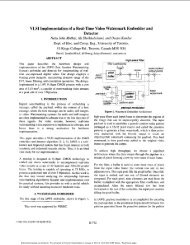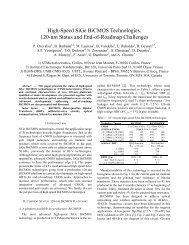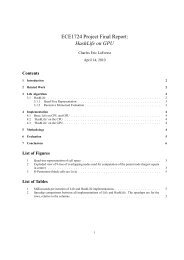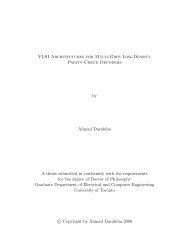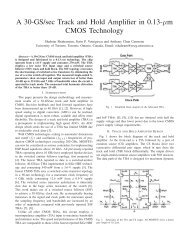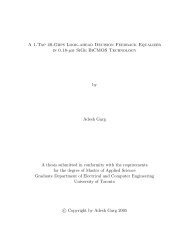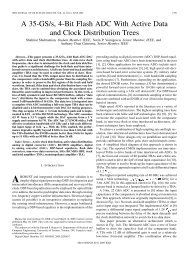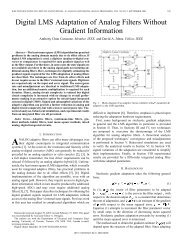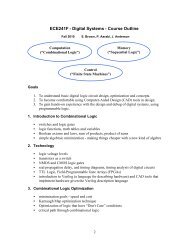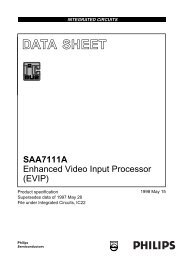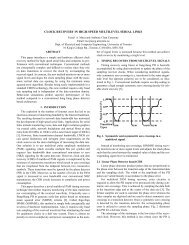ieee transactions on very large scale integration (vlsi) - Computer ...
ieee transactions on very large scale integration (vlsi) - Computer ...
ieee transactions on very large scale integration (vlsi) - Computer ...
You also want an ePaper? Increase the reach of your titles
YUMPU automatically turns print PDFs into web optimized ePapers that Google loves.
YANG et al.: EXTRACTION ERROR MODELING AND AUTOMATED MODEL DEBUGGING IN HIGH-PERFORMANCE CUSTOM DESIGNS 771<br />
the is updated by copying to the<br />
column which is main-indexed with (line 12). Intuitively, the<br />
columns of<br />
under the same main index c<strong>on</strong>tain<br />
the values of the PIs prior to the last indexed clock triggered. Finally,<br />
the is updated with the input vector (line 16).<br />
In our implementati<strong>on</strong>, we use a parallel bitwise implementati<strong>on</strong><br />
for both the storage tables and for the simulati<strong>on</strong> retrieving as<br />
many test vectors as the length of the computer word [9].<br />
The values stored in the tables are used appropriately by<br />
ENHANCED_PATH_TRACE to restore logic values in the core circuitry<br />
and assist path-trace during diagnosis. When path-trace<br />
marks the registers in register layer II, it reads the proper entry<br />
in<br />
and retrieves the correct values in combinati<strong>on</strong>al<br />
circuitry B by simulating the circuitry with the values<br />
read from the table. Then, path-trace proceeds by marking in<br />
the combinati<strong>on</strong>al circuitry B (lines 24–26). When it reaches<br />
the registers in register layer I, it again reads the entry in<br />
according to clocks c<strong>on</strong>trolling the registers <strong>on</strong><br />
the path and restores the states of the lines in combinati<strong>on</strong>al<br />
circuitry A. Path-trace c<strong>on</strong>tinues marking in core circuitry A<br />
and terminates when it reaches a primary input of the circuit,<br />
as explained earlier. These acti<strong>on</strong>s are taken in lines 29–31.<br />
The above procedures are utilized when no state equivalence<br />
informati<strong>on</strong> is available. In the cases of partial and full state<br />
equivalence, path-trace can start marking from err<strong>on</strong>eous primary<br />
outputs as well as memory elements that propagate err<strong>on</strong>eous<br />
logic values and their state equivalence informati<strong>on</strong> is<br />
available. We omit this code which is a straightforward extensi<strong>on</strong><br />
of the <strong>on</strong>e presented earlier.<br />
In the final paragraphs of this secti<strong>on</strong>, we analyze memory<br />
requirements for the various tables. In this analysis, we partiti<strong>on</strong><br />
the circuit to allow the primary input to be at stage 0, the register<br />
layer I at stage 1, and so <strong>on</strong>. We also assume that, for stage<br />
, there are memory elements (primary inputs) and local<br />
clocks.<br />
Using the above notati<strong>on</strong>, it can be shown that the size<br />
(i.e., number of table entries) of the <strong>large</strong>st table at stage<br />
is , where is the maximum number of<br />
pipeline stages. Recall that each stage maintains additi<strong>on</strong>al<br />
smaller tables for all subsequent stages. Therefore, the<br />
size of the total number of tables at stage is found to be<br />
. Using this result, the total number of<br />
tables for the complete design is .<br />
To further analyze the memory requirements as the number of<br />
pipeline stages increases, for the sake of simplicity, we assume<br />
that the number of registers and the number of local clocks for<br />
each register layer in e<strong>very</strong> pipeline stage is upper bounded by<br />
and , respectively. In other words, and ,<br />
. Using this upper bound, the total number of table entries<br />
is<br />
. It can be seen that, for e<strong>very</strong> increase<br />
in the number of pipeline stages , the number of table entries<br />
increases roughly by factor of . For example,<br />
, and so <strong>on</strong>,<br />
or, in general, .<br />
It is seen that the size of the table entries relates to the number<br />
of clocks per pipeline stage and the total number of pipeline<br />
stages in an exp<strong>on</strong>ential manner, a fact that may require prohibitive<br />
amounts of memory for <strong>large</strong> industrial designs with<br />
<strong>very</strong> deep pipelines. This is expected since the algorithm handles<br />
a sequential model with no state equivalence informati<strong>on</strong><br />
to the transistor level. However, in practice, deep pipelines are<br />
usually designed in blocks of smaller (pipelined) stages to ease<br />
test generati<strong>on</strong>, verificati<strong>on</strong> etc [15]. Additi<strong>on</strong>ally, the number of<br />
local clocks and the number of pipeline stages is a small fracti<strong>on</strong><br />
to the total number of circuit lines. Finally, the trend today<br />
in high-performance designs is multithreading <strong>on</strong> small-sized<br />
pipelines due to power and reliability c<strong>on</strong>cerns. Therefore, in<br />
most practical cases, the debugging algorithm is expected to be<br />
memory efficient.<br />
B. -Simulati<strong>on</strong><br />
In most model-dependent diagnosis algorithms, the effects<br />
of the faults/errors are explicitly specified [9], [14]. During<br />
diagnosis, a model-dependent algorithm usually performs <strong>on</strong>e<br />
logic simulati<strong>on</strong> step for e<strong>very</strong> error model manifestati<strong>on</strong> <strong>on</strong><br />
each suspect line. Therefore, this type of diagnosis is more<br />
suitable for simple faults/errors where their effects are easy to<br />
enumerate [14]. For example, the effects of a stuck-at fault are<br />
modeled with <strong>on</strong>ly two values 0 and 1 and, for each suspect line<br />
, the algorithm can perform two simulati<strong>on</strong>s, stuck-at-0 and<br />
stuck-at-1. to see the effects of the candidate fault. However,<br />
for complicated faults/errors, such as the extracti<strong>on</strong> errors<br />
presented here, the cardinality of the error models may be <strong>large</strong>,<br />
and it may be computati<strong>on</strong>ally expensive to simulate each<br />
such effect during diagnosis. In this case, model-free diagnosis<br />
seems to serve better in tackling the problem [14].<br />
Model-free diagnosis simulates a logic unknown value<br />
<strong>on</strong> candidate error lines to capture all possible paths for error<br />
propagati<strong>on</strong> [14]. In the proposed debugging algorithm, after<br />
path-trace returns a set of candidate error locati<strong>on</strong>s, the algorithm<br />
performs this -simulati<strong>on</strong> step using failing input test<br />
vectors. Because of multiple error sites in the netlist, the true<br />
candidate error locati<strong>on</strong>s must be marked by path-trace at least<br />
times, where is the cardinality of failing input test<br />
vectors and is the number of err<strong>on</strong>eous module instantiati<strong>on</strong>s.<br />
This claim is proved in terms of a simple theorem in [14] using<br />
the pige<strong>on</strong>-hole principle, and we refer the reader to that paper<br />
for details. Furthermore, recall that these multiple error sites are<br />
instances of <strong>on</strong>e single module. In other words, we can prune the<br />
size of the candidate list further using the following rule. The<br />
sum of path-trace marks for all instantiati<strong>on</strong>s of a candidate<br />
error module must be greater or equal to . -simulati<strong>on</strong> is<br />
performed <strong>on</strong> modules that qualify this rule.<br />
Since some error types involve the logic unknown , we introduce<br />
a sec<strong>on</strong>d unknown value and simulate this value <strong>on</strong><br />
the candidate error locati<strong>on</strong>s. Under this scenario, if a gate primitive<br />
has an input with c<strong>on</strong>trolling value, then this input prevails,<br />
otherwise value prevails over any other input. For example,<br />
a two-input gate with fan-in values of 0 and evaluates<br />
to 0 while <strong>on</strong>e with values and or 1 and evaluates to<br />
. A module qualifies for correcti<strong>on</strong> if this simulati<strong>on</strong> of the<br />
value propagates to all err<strong>on</strong>eous primary outputs [14].



